DESIGN-CENTRED KNOWLEDGE INCUBATOR MAKER’S
20 Credit Journal Haeun Kim
PLAYGROUND
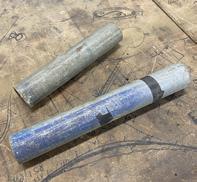
‘We like to rearrange things which are already there in one way or another, to curate them anew,’
- pihlmann architects
The Glue Factory, initially designed by John Keppie in 1891 (with the assistance of a junior, Charles Rennie Mackintosh), stands today as a unique symbol of its profound historical significance. Within its walls lie various features that offer a glimpse into its impressive past. For example, remnants of its industrial history, such as a tank and pipes on the ground floor, serve as tangible reminders of its former use. Additionally, the sturdy barn doors crafted from steel and wood and the traces on bricks and roofs further describe the story of its shift over time.
During recent months of on-site exploration, I had the opportunity to secure original materials from the building, particularly those utilised in its roof and flooring—natural timber instead of engineered timber. Through this process, I was able to encounter detailed features of the timber, including handmade nails believed to have been crafted in the 1800s. By repurposing this discarded timber into new forms, I aim to showcase the importance of material recycling, a fundamental aspect of my project. I have created multiple material blocks, pairing timber with porcelain stoneware tiles, acoustic material panels, and other new materials. These blocks were designed to show how the old and new materials could potentially interact in the newly imagined space. This exercise also allows the audience to experiment with their own pairings and display how old and new materials can blend. By preserving existing materials and integrating new ones, I hope to create a space with a vibrant atmosphere while advocating for environmentally conscious practices.
The British architectural partnership, Benson & Forsyth, is renowned for its museum and cultural facility design, with its most notable project being the National Museum of Scotland. It is a fine example of adaptive re-use and preservation. The building, a cultural landmark representing Scotland’s rich history and heritage, prioritised conserving and utilising existing historic structures to maintain their inherent value. Benson & Forsyth endeavoured to retain as much of the original building’s materials and structure as possible while creating new spaces through renovation. They preserved Scotland’s traditional architectural style by re-using bricks and timber while providing a modern appearance by incorporating glass and steel to efficiently use the space and capture natural light.
Learning from the case study, I seek to preserve and maintain existing materials, prolonging the lifespan of the timber roof and flooring. Alongside timber, I aim to reinvent the Glue Factory by retaining core features such as concrete flooring, steel beams, and steel doors. In my final project proposal, I plan to demolish the floor to create a double-height space. Using the timber generated from this, I aim to create new doors, furniture, and more while preserving the original essence and enhancing functionality and aesthetic appeal. Any remaining timber will also be delivered to the Glasgow Wood Recycling Centre to promote sustainability. Through carefully considering material re-use and innovative design, I seek to revitalise the Glue Factory with rooms suited for creativity and collaboration.
INSPIRING
Observe the existing features
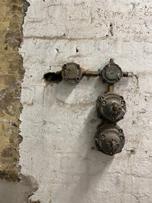


EXPLORING
Collect the existing materials
Timber from the roof
Timber pieces from the joist
Timber from the flooring

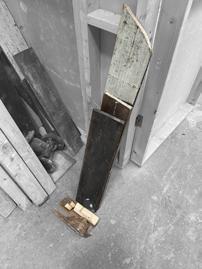
DOCUMENTING
Archive the materials


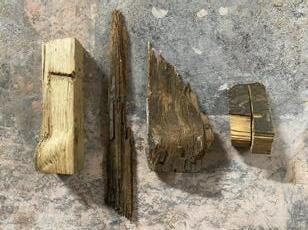

1. Abandoned timber used for the roof and the floor
2. Abandoned timber pieces from the joists
3. Diverse traces on the existing timber
4. Tree ring detail from the existing timber
DOING
Refine the timbers
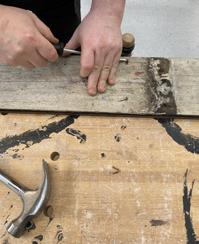




1. Denailing
2. Sanding the rough surface
3. Refining timber
4. 10x10, 10x4.5 (mm) tailored timber
5. Handmade nails from the 1800s
1 1 2 3 4 2 3 4 5
SHARING
Existing materials_Timber

 02 Timber from the flooring
01 Timber from the roof
02 Timber from the flooring
01 Timber from the roof



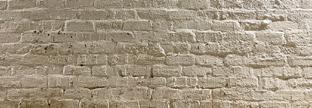 03 Concrete flooring
04 Bricks
03 Concrete flooring
04 Bricks
SEATING WORKING AREA : behind the shelf
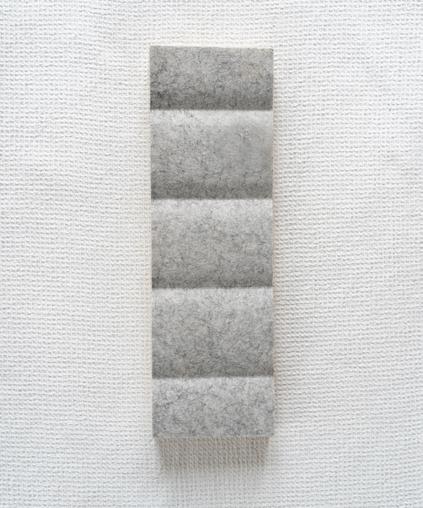
This Alto Acoustics material crafted entirely from 100% polyester, offers a variety of product solutions designed to enhance workplace acoustics by reducing noise levels and minimising sound reverberation. With a composition of 60% recycled polyester fibre and 40% virgin polyester fibre, it not only contributes to a quieter and more focused work environment but also promotes sustainability.
New materials
SHARING
05 Alto Acoustics_Alto Reed Smoke
SEATING WORKING AREA
ASSEMBLY AREA
: column, wall
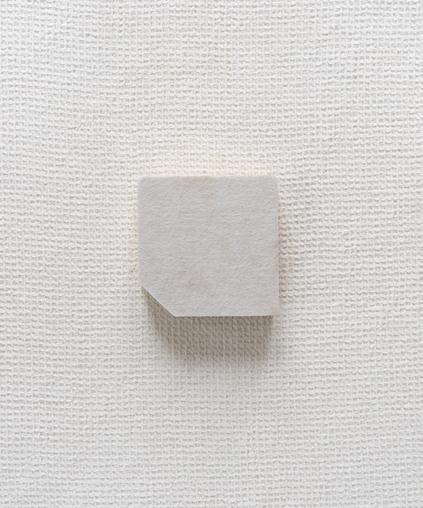
Alto panels exemplify a Circular Economy by diverting waste from landfills and repurposing plastic bottles into functional, sustainable designs for commercial interiors.
The product is available in a selection of 23 standard colours
06 Alto Acoustics_Alto Reed Dune
KITCHEN : flooring

07 Mutina_Fringe Bold Grey
This unglazed and “brick like” porcelain stoneware is available in 120, 30 x 120, 30 mm. It offers two variations: Thin, 6mm segments, and Bold, 15mm segments. Designed for modularity, it features a 3mm joint.
Its versatile design allows for weaving into various patterns simply by altering the orientation, offering flexibility and creativity in installation.
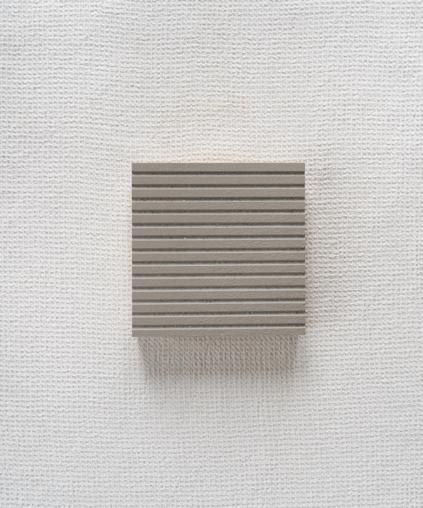
08 Mutina_Fringe Thin Grey
“I always liked how open plan interior allow for different functions to take place in multiple layouts. Yet, the space always seems to divide itself naturally in clearly defined areas, as a sequence of activities across the floor. You can imagine these taking place over a series of perfectly fitted rectangular carpets, each with a different pattern, marking a territory for each act. The most interesting moment is the point when you move from one to the next, the act to follow defined by the fringe around the borders.”
- Michael Anastassiades,
the designer of the Fringe collection.
KITCHEN : flooring

BASWA is dedicated to pioneering product development utilising plant fibres, recycled glass, marble sand, organic binders, and minimising the use of synthetic materials. Their acoustic solutions consist of up to 94% recycled and natural materials, including waste from other production processes, with ongoing efforts to integrate additional plant-based components in the future.
Their seamless systems, available in a wide range of colours and surface smoothness options, carefully enhance room acoustics in any interior setting. Ideal for rooms, halls, and public buildings of all sizes and architectural style.
09 Baswa Acoustic_Classic Fine
ASSEMBLY AREA : wall
SHARING
Possible materials
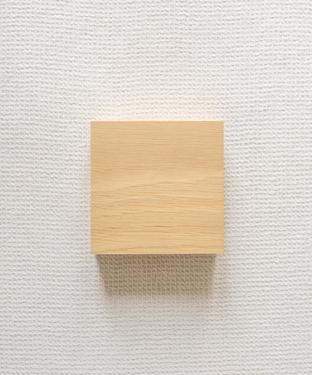

10 Noesis_Gocce Argan
Noesis engineered wood flooring shows their careful craftsmanship and love for natural materials. Their well-known 2-layer boards are certified to last and look consistent, showing how dedicated they are to quality.
The Gocce collection shows the natural charm of wood by bringing out its tiny flaws with deep brushing, revealing its raw and genuine look.
11 Grestec_Design two TCD35628
Design Two collection offers a wide selection of thirty plain and speckled colours, available in five anti-slip surface finishes, making it versatile for both wall and floor applications.
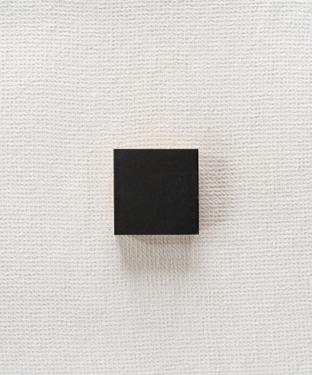

Richlite is a tough, eco-friendly material made from paper. Crafted by hand from top-quality paper infused with a special resin, it’s strong , durable, 100% recycled and sustainable. With its solid construction and smooth surface, Richlite is perfect for machining and comes in a range of applications.
Corian® Solid Surface offers seamless beauty and hygiene, perfect for various applications. With its non-porous and seamless design, it resists stains and prevents bacteria and mold growth. It is durable and repairable, maintaining its stunning appearance for years.
Environmentally friendly with low VOCs* and recycled content in select colours, it supports better indoor air quality, while our manufacturing facilities strive for zero waste to landfill.
* Gases are released from specific solids or liquids, known as Volatile Organic Compounds (VOCs).
12 Richlite_Blue Canyon
13 Corian®_Golden Onyx


Polygood is a surface material crafted from 100% recycled plastic by The Good Plastic Company. Each pattern tells a unique story, sourced from post-consumer and post-industrial plastic waste, ranging from refrigerators to electronics. The Polygood Core range offers a blend of naturalistic and modern patterns in stylish colour palettes, ideal for large-scale interior and exterior projects. Clients can also create bespoke patterns tailored to their needs, ensuring sustainability and style for years to come.
This wood veneer product features Ayous species, with pre-glued non-woven fabric. It is suitable for curved applications and offers consistent colour and tone.
14 The Good Plastic Company _Polygood #PS1507
15 Havwoods_Oak Ondato M23.5 Sheet
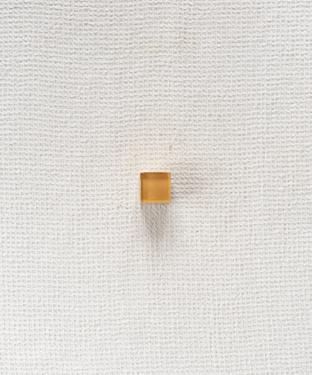
16 Blueprint Ceramics_BPBMPDV16
Crystal Glass 23 collection offers mosaic tiles infused with vibrant colours and crystalline refractions, creating a brilliant three-dimensional effect. Ideal for contemporary design projects, it boasts a full range of vivid shades and minimalist tones. With bespoke mix options, designers can create unique visual experiences tailored to their concepts.
It is available in 23x23 mm, with 8 mm thickness.
PRESENTING
During the degree show, visitors will have the opportunity to craft their own material palette, combining preserved timber over a century old with new materials. This provides a chance for physical interaction with my project.
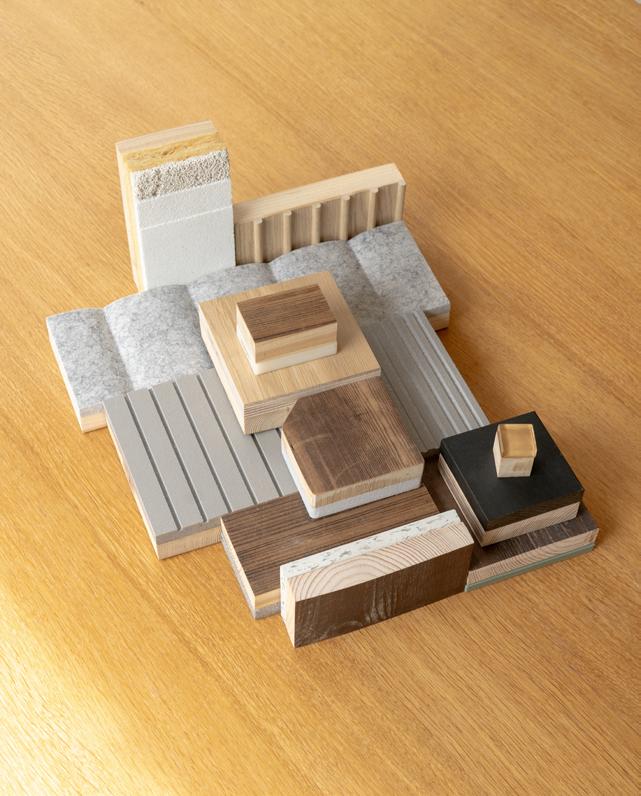
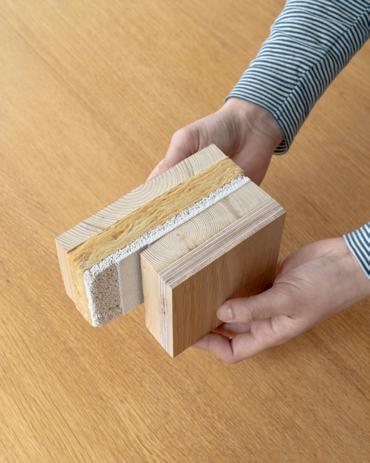
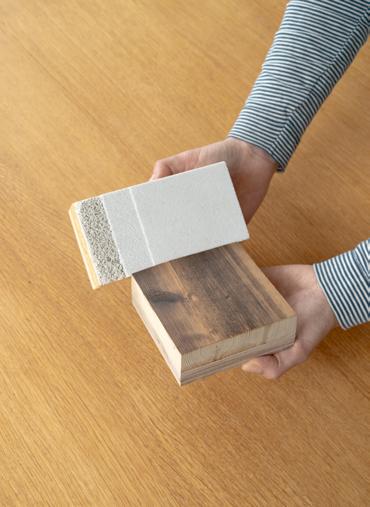

















 02 Timber from the flooring
01 Timber from the roof
02 Timber from the flooring
01 Timber from the roof



 03 Concrete flooring
04 Bricks
03 Concrete flooring
04 Bricks














